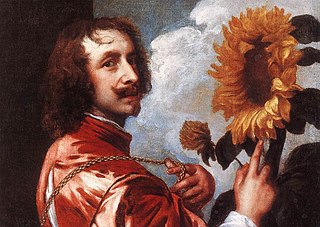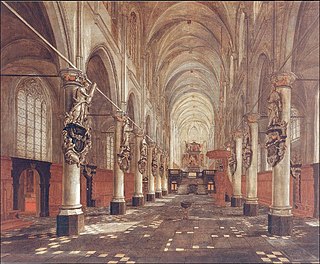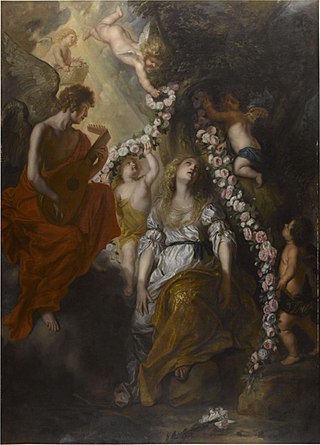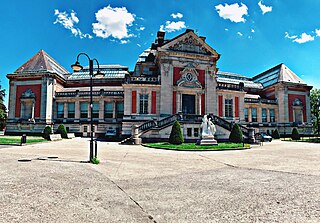
The Crucifixion is an oil on canvas painting by Anthony van Dyck, produced c. 1630. It is 2.51 m high.

The Crucifixion is an oil on canvas painting by Anthony van Dyck, produced c. 1630. It is 2.51 m high.
It was originally commissioned as the high altar-piece in the convent of the Récollets in Lille during van Dyck's second Antwerp period, between his return from Italy in 1627 and his departure for London in 1632. It returned to a theme he had already painted around 1617-19 during his first Antwerp period, when he was still a studio-assistant to Rubens - this was Crucifixion with the Virgin Mary, St John and St Mary Magdalene , sold to Rubens in 1621 as the high altarpiece for the Jesuit church at the abbaye Saint-Winnoq in Bergues, now in the musée du Louvre. [1] The second work's composition is more original, with a less central cross in an oblique position to give depth to the scene. The sky and the Magdalene's hair show the influence of the Venetian masters van Dyck had seen during his time in Italy.
It was seized during the French Revolution and in 1795 it was part of the founding collection of the Palais des beaux-arts de Lille, where it still resides. [2] [3]
The three colours worn by the three mourners are symbolic: [4] golden yellow by Mary Magdalene (eternal light), red by John the Evangelist (the Passion) and blue by the Virgin Mary (the mantle of humanity). The third shadowed figure to the far right is unclear, but may be one of the Three Marys. The crucifixion occurred at Golgotha ("the place of the skull") and so Adam's skull is shown at the foot of the cross, to the lower left, under a thistle, symbolising the misfortune of the Fall and Original Sin, [4] its spines invoking Christ's crown of thorns. In the semi-circle above the cross is a 'mystic delta' symbolising the Holy Trinity.

Sir Anthony van Dyck was a Flemish Baroque artist who became the leading court painter in England after success in the Spanish Netherlands and Italy.

Simon Vouet was a French painter who studied and rose to prominence in Italy before being summoned by Louis XIII to serve as Premier peintre du Roi in France. He and his studio of artists created religious and mythological paintings, portraits, frescoes, tapestries, and massive decorative schemes for the king and for wealthy patrons, including Richelieu. During this time, "Vouet was indisputably the leading artist in Paris," and was immensely influential in introducing the Italian Baroque style of painting to France. He was also "without doubt one of the outstanding seventeenth-century draughtsmen, equal to Annibale Carracci and Lanfranco."

The Descent from the Cross, or Deposition of Christ, is the scene, as depicted in art, from the Gospels' accounts of Joseph of Arimathea and Nicodemus taking Christ down from the cross after his crucifixion. In Byzantine art the topic became popular in the 9th century, and in the West from the 10th century. The Descent from the Cross is the 13th Station of the Cross, and is also the sixth of the Seven Sorrows of the Blessed Virgin Mary.

The Elevation of the Cross is the name of two paintings, a very large triptych in oil on panel and a much smaller oil on paper painting. Both pieces were painted by the Flemish artist Peter Paul Rubens in Antwerp, Belgium, the original in 1610 and the latter in 1638.

The Descent from the Cross is the central panel of a triptych painting by the Baroque artist Peter Paul Rubens in 1612–1614. It is still in its original place, the Cathedral of Our Lady, Antwerp, Belgium. The painting is considered to be one of Ruben's masterpieces. The painting depicts the moment when the body of Jesus Christ is taken down from the cross after his crucifixion. The subject was one Rubens returned to again and again in his career. The artwork was commissioned on September 7, 1611, by the Confraternity of the Arquebusiers, whose patron saint was St. Christopher.

Theodoor Boeyermans, Theodor Boeyermans or Theodor Boeijermans was a Flemish painter active in Antwerp who painted Baroque history paintings and group portraits informed by the tradition of Peter Paul Rubens and Anthony van Dyck.

The Palais des Beaux-Arts de Lille is a municipal museum dedicated to fine arts, modern art, and antiquities. It is one of the largest art museums in France.

Arnould de Vuez was a painter of Flemish origin active in Lille from 1680 to 1720.

Sir Peter Paul Rubens was a Flemish artist and diplomat from the Duchy of Brabant in the Southern Netherlands. He is considered the most influential artist of the Flemish Baroque tradition. Rubens's highly charged compositions reference erudite aspects of classical and Christian history. His unique and immensely popular Baroque style emphasized movement, colour, and sensuality, which followed the immediate, dramatic artistic style promoted in the Counter-Reformation. Rubens was a painter producing altarpieces, portraits, landscapes, and history paintings of mythological and allegorical subjects. He was also a prolific designer of cartoons for the Flemish tapestry workshops and of frontispieces for the publishers in Antwerp.

Schelte a Bolswert (1586–1659) was a leading Dutch engraver, noted for his works after Rubens and Van Dyck.

Pieter van Mol or Peter van Mol was a Flemish painter known for his history paintings of religious subject matter, and to a lesser extent for his allegorical compositions, genre scenes and portraits. His style was profoundly influenced by Rubens, Abraham Janssens and Artus Wolffort. He was court painter to the King and Queen of France.

Paulus Pontius was a Flemish engraver and painter. He was one of the leading engravers connected with the workshop of Peter Paul Rubens. After Rubens' death, Pontus worked with other leading Antwerp painters such as Anthony van Dyck and Jacob Jordaens.

St Mary Magdalene in Ecstasy or The Death of St Mary Magdalene is an oil-on-canvas painting by Peter Paul Rubens, completed c. 1619–1620. It shows Mary Magdalene supported by two angels. The painting was produced for the Friars Minor in Ghent. It was seized by French occupation troops in 1794 and taken to Paris, before being allocated to the newly founded Palais des Beaux-Arts de Lille, where it is now housed.

The Descent from the Cross is a painting by Peter Paul Rubens, executed around 1616–1617 for the chapel of the Capuchin convent in Lille, France. It was seized by France and was part of the founding collection of the Palais des Beaux-Arts de Lille, where it is still housed.

The Vision of the Blessed Hermann Joseph or The Mystical Engagement of the Blessed Hermann Joseph to the Virgin Mary is a 1629-1630 painting by the Flemish Baroque painter Anthony van Dyck.

Crucifixion with the Virgin Mary, St John and St Mary Magdalene is a painting by Anthony van Dyck. He produced it in 1617-19 as the high altarpiece for the Jesuit church in Bergues, near Dunkirk, during his time as an assistant painter to Peter Paul Rubens - for a long time the painting was even attributed to Rubens. It was paid to Rubens in 1621 and seems to have been sold around 1746. It was bought by Louis XV of France in Antwerp in 1749 to be the high altarpiece of Saint-Louis de Versailles at the Palace of Versailles. It is now in the Louvre, in Paris.

The Oldmasters Museum is an art museum in Brussels, Belgium, dedicated to European painters from the 15th to the 18th centuries. It is one of the constituent museums of the Royal Museums of Fine Arts of Belgium. The museum was founded in 1801 by Napoleon. It was originally named the Musée royal d'art ancien.

Noli me tangere or Christ Appearing As A Gardener To Mary Magdalene is a 1548-1560 painting by the Flemish painter Lambert Sustris. It is now in the Palais des beaux-arts de Lille.

The musée des beaux-arts de Valenciennes is a municipal museum in the French town of Valenciennes. Its collections originated as the collection of the Académie valenciennoise de peinture et de sculpture. It opened to the public for the first time in 1801 and was moved into the town hall in 1834.